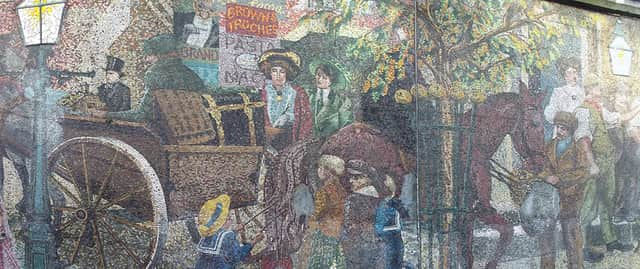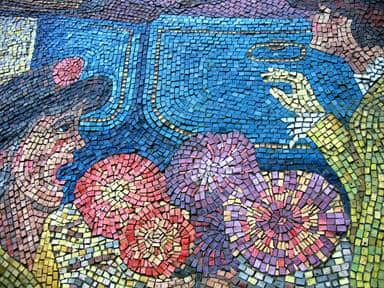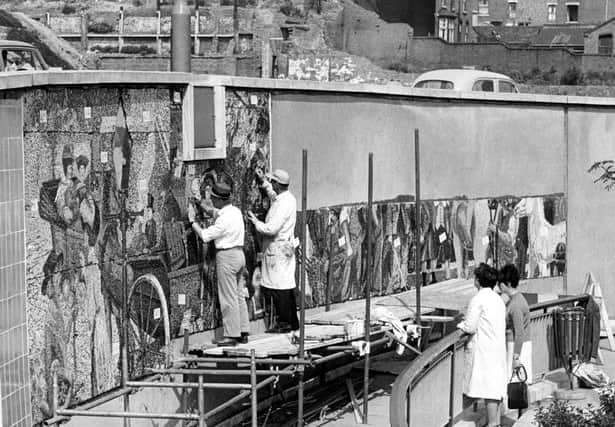Campaign to save iconic 1960s mural in Birmingham city centre launched - here’s why
and live on Freeview channel 276
It’s the 85ft long mural in the underpass in Birmingham city centre - by the Radisson Blu hotel near Smallbrook Queensway where you will find the Chinese Pagoda.
The Horse Fair mural was created in 1966 by artist Kenneth Budd and depicts the centuries old custom of trading horses in the area. The JFK mural in near the Custard Factory in Digbeth is by the same artist - he created six murals for Birmingham in total.
Advertisement
Hide AdAdvertisement
Hide AdThe one at Holloway Circus is the only one that remains in its original position, but there are concerns that its condition is deteriorating and that its future could be in doubt. Birmingham City Council is planning to ‘decommission’ the mosaic due to its poor condition explaining that the materials used to created were not designed to withstand sixty years in the outdoors..
But the Twentieth Century Society (C2O) is campaigning to save the Horse Fair mural - and has applied to list the artwork. C20 believes the mural is an exceptionally ambitious and skillful work executed by a master mosaicist - and remains an important example of post war public art.
They say that listing the mural would help to ensure that the artwork is properly documented, removed, restored and reinstalled. It cites the success of other artworks, such as the notably the Dorothy Annan murals (c.1960), in London which were listed Grade II in 2011, then carefully removed from the Fleet Building and re-listed in their new location at the Cromwell Highwalk at the Barbican in 2016.


History of the Horse Fair mural
Unveiled by The Lord Mayor of Birmingham Alderman H. E Tyler J.P. on June 30, 1966 the mural is located on the western side of Thomas Gardens in the Holloway Circus roundabout. The roundabout was built at the top of Smallbrook Queensway (formerly Smallbrook Ringway) as part of the Inner Ring Road development, built between 1957 and 1970. The mural depicts activities in the Horse Fair which took place in this area until 1911, and was the last remaining fair of the charter granted by Henry III in 1215.
Advertisement
Hide AdAdvertisement
Hide AdThe site also once accommodated a statue of Hebe (1966), which was designed by Les Howles of the city architect’s department then sculpted and cast in bronze by J.R. Thomas. In 2005, the statue was reported as being “in store”. The roundabout was re-landscaped in 1998 by Birmingham Design Services and a Chinese pagoda installed.
Design of the Horse Fair mural in Birmingham
The mosaic is a remarkable large-scale work which is bold and colourful but also includes fine and intricate detail.
Budd split the mural into 4 sections and worked on the mosaic with his colleague Alan Kemp and former student Paul Fink. They used Venetian ‘smalti’ – highly coloured Italian glass, produced in small pieces from larger slabs and designed for mosaic use because it enables fine detail.
Horses and figures are carefully picked-out and faces are expressive and animated. As recorded in an article by Professor Carl Chinn, among those who came to watch the work being installed was a man who ran a horse and carriage wedding service. The man identified the types of horses and said that “his old dad who remembered the old Horse Fair would vouch for the authenticity of the work”.
Advertisement
Hide AdAdvertisement
Hide AdThe wall at Holloway Circus was prepared with cement render, then covered with adhesive and the mosaic panels installed one section at a time, secured with Hilte gun fixings. After the sections had been affixed, any gaps between them were filled with additional smalti. This was followed by grouting with Bal-grout cement powder, which was coloured grey to match the shadows between ungrouted tessera. Finally it was washed with diluted solution of spirits of salts, to remove any grout film remaining and hosed with clean water. Once dry, it was treated with two applications of a silicon solution to aid the prevention of water penetration.
However, over the intervening 50 years the mural has indeed suffered from water ingress and damp, with patch repairs failing to address the deterioration in its condition. This has hastened in recent years, with an estimated 15% of the mosaic now lost. Sympathetic cleaning, digital recording and careful relocation or reinstallation would ensure this historically important artwork can be saved for future generations.


Who is Kenneth Budd?
The artist Kenneth Budd trained at the Royal at the Royal College of Art in mural design and painting under Kenneth Rowntree, graduating in 1951. He joined the firm of William Mitchell and Partners in 1961 when this firm was pioneering art for public spaces and buildings and confirming Mitchell’s status as a leading post-war British muralist and sculptor.
Budd assisted Bill Mitchell in a mural for Derby College of Technology and cast concrete bas-reliefs for the London Boroughs of Lewisham and Wandsworth. At this time Budd developed the use of polychromatic glass mosaic in murals, based on Italian techniques, thereby replacing the traditional painted form which was difficult to make weatherproof in England. Following his work in the mid-1960s with the William Mitchell Studio on the so-called Civil War Mosaic and the Industrial Mosaic for Birmingham City Council (both now destroyed), Budd went out on his own and in 1968-69 secured contracts for two huge mosaics in Birmingham at St Chad’s Circus, the John F Kennedy Memorial mosaic and the Great Western Railway Mosaic.
Advertisement
Hide AdAdvertisement
Hide AdSt Chads Circus was redeveloped and the Kennedy mural dismantled in 2007. Kenneth’s son, Oliver, recreated the mosaic in a new location, on the corner of Deritend High Street and Floodgate Street in Digbeth. Some sections of the Great Western Railway mural were removed but most was buried on site.
In the 1970s, Budd was commissioned by Newport City Council to produce two mosaics, the Chartist Mural and the Monmouthshire Railway and Canal Company Mural, and cast concrete bas reliefs for the Inner Ring Road. The Chartist Mural was destroyed in 2013, following a rejected listing application by C20. Much of Budd’s work has been lost and none yet listed, making the Horse Fair mosaic an important and rare surviving work by a major post-war British mosaic artist.


What has the Twentieth Century Society said about saving the Horse Fair Mural in its own words?
C20 Society Director, Catherine Croft said: “Kenneth Budd’s wonderful, polychromatic Horse Fair Mural is one of the largest mosaic murals in the country. It tells a unique story of Birmingham’s people and customs, yet swift action is required to prevent it from being lost altogether.
“Listing would recognise this important part of the city’s post-war heritage, and help to ensure a sensitive restoration or relocation.
Advertisement
Hide AdAdvertisement
Hide Ad“Since launching in 2009, C20’s Murals Campaign has been one of our most successful initiatives, with more than 30 examples nationally listed and countless others saved. We hope the Horse Fair mural can be another case with a happy outcome!”
What has Birmingham City Council said about the Horse Fair Mural at Holloway Circus in its own words?
A Birmingham City Council spokesperson said: "We commissioned an independent condition report for this mural through our public art maintenance programme which included consultation with the original artist’s son and we have had a number of meetings with him.
"The issue we face is that the original materials and plaster construction used at the time were not conducive to withstanding damp and water ingress over sixty years so we believe there is no realistic option but to decommission the mosaic.
"We intend to consult as to the best way forward and remain in discussion with the artist’s son and relevant stakeholders."
Comment Guidelines
National World encourages reader discussion on our stories. User feedback, insights and back-and-forth exchanges add a rich layer of context to reporting. Please review our Community Guidelines before commenting.
